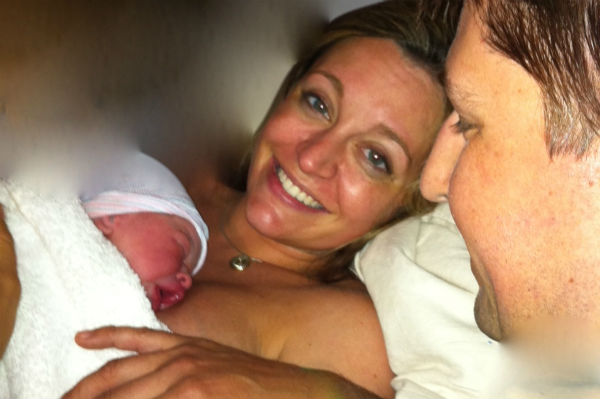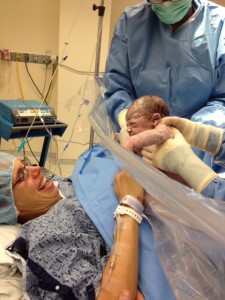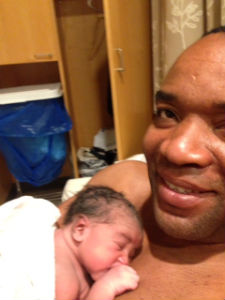This Friday, May 15th, we celebrate Kangaroo Care Awareness Day. We are huge advocates of the practice and passionately believe in all of the benefits of kangaroo care, which is commonly called skin-to-skin contact. Kangaroo Care is so important for both babies + moms, and is a practice that begins the minute baby is born.
We are thrilled to see the increasing emphasis of Kangaroo Care in hospitals, along with protocols to implement new standards of care that are baby and family friendly. One of the hospitals that continues to lead the charge in family-centered care is Brigham and Women’s Hospital in Boston, MA. In honor of Kangaroo Care Awareness Day, Kathy Trainor, RN, IBCLC, with Brigham and Women’s Hospital, shares this guest post with us about the importance and changing face of skin-to-skin contact in the delivery room. Kathy has been instrumental in championing practices such as the “Gentle-C” at BWH and we couldn’t be more honored to share this post from her today.
“Skin to skin care is the most natural gift that you can give your newborn baby. Babies brains are equipped from the moment of birth to search for and find the breast. It is their instinctual behavior that allows them to be successful at breastfeeding and skin-to-skin care gives them the optimal chance to accomplish this important task. Oxytocin is the powerful hormone that signals the baby and the mother to work together and it is expressed in greater amounts through direct skin contact. In the past, many hospitals would take the baby immediately upon birth and place them in the warming crib for the nurse to perform routine tasks such as weighing, measuring, erythromycin ointment to the their eyes and a vitamin K shot to their thigh. How traumatic to the newborn and against all nature to be away from their mother!
Many neuroscientists have discovered over the last forty years, through multiple research studies, the benefits of skin-to-skin care immediately upon birth. Studies have shown the first hour of life to be the most important time for the baby because the baby is at the highest alert state and the mother is also. Providing direct skin-to-skin care starts the process of bonding with one another and allows for a greater success with breastfeeding.
In today’s practice at the Brigham and Women’s Hospital, we have gone back to the way nature intended birth to be, by allowing mom + baby to stay together skin-to-skin immediately after birth, giving baby time to naturally seek out the breast. Hospitals have interrupted that window with needing to complete routine procedures, which we now all realize can wait until after mom + baby have shared that time together.
And, today’s present day practice for mothers having cesarean births at BWH also includes the opportunity for moms to provide skin-to-skin care for their newborns. In the spring of 2012, Dr. Bill Camann, Director of Anesthesia, and I starting using a clear sterile drape so that mom could see the birth of her baby. You can just imagine how happy mothers were to see and touch their baby through the drape. Families were so excited to finally be a part of the birth process and especially to be able to hold their newborn within the first five minutes of life. This new technique was groundbreaking not only for families but also for the most important member of the birth, the baby!
Sometimes it is difficult for mothers during a C-section to hold the baby. But not to worry! We as the delivery team at BWH always have a back up plan to provide skin to skin care for the baby and make sure the father of the baby or significant other is ready for baby to be placed skin-to-skin with them.
The changes we have brought to the delivery room over the past few years have come with some resistance. But most would now agree: the results of increased breastfeeding rates, natural bonding for the newborn and just overall joy by the parents and providers speaks loudly to sharing the value of immediate direct skin-to-skin care with future parents and families.
The media agrees and CNN recently featured our Gentle-C practice and procedures. Both Dr. Camann and I have spoken at conferences on the topic and will continue to do so! Find us speaking together this fall at the Mass Breastfeeding Coalition in September on the clear drape technique in the operating room.”
About Kathy Trainor, RN, IBCLC, CCE
Kathy received her RN BSN from Salem University. She is an internationally board certified lactation consultant and certified childbirth educator. Kathy has worked at Brigham and Women’s Hospital in Boston in women’s health over the last 30 years. She has helped countless numbers of women and their families welcome their newborns into the world. She is also a pioneer in educating nurses and doctors to bring skin-to-skin care to the bedside for vaginal deliveries. She developed the clear drape technique, along with her colleague, Dr. Bill Camann, to allow mothers to see the birth of their baby during a C-section delivery. Kathy lives with her husband and is the mother of three children and one grandchild. She is fondly referred to by her colleagues as “The Milk Lady”!
*All photos used with permission from Kathy Trainor.



